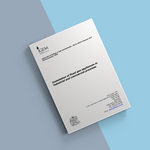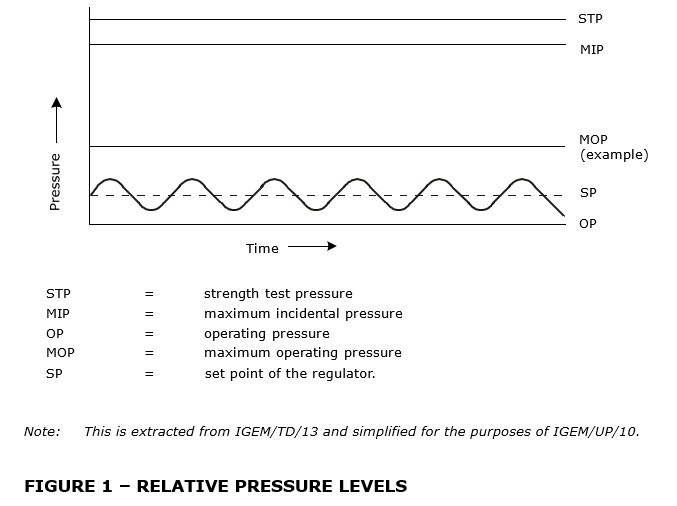IGEM/UP/10 Edition 4 +A: 2016 and 2017 - Installation of flued gas appliances in industrial and commercial premises

These procedures apply to gas fired open flued and room sealed appliances, including:
- Hot water boilers of net heat input exceeding 70 kW
- Steam boilers
- Thermal fluid heaters
- Storage water heaters of net heat input exceeding 70 kW
- Warm air heaters of net heat input exceeding 54 kW
- Radiant heaters.
They cover 1st, 2nd and 3rd family gases and apply to new appliances, along with retrofitting of burners to existing appliances.
It contains details of:
- Legislation such as Gas Safety (Installation and Use) Regulations
- Selection of appliances
- Location of appliances and pipework
- Design of pipework
- Ventilation
- Chimneys, including construction and material choice
- Gas and fire detection and hazardous areas
- Commissioning and handover
- Servicing and maintenance.
Introduction
1.1 This Standard supersedes IGEM/UP/10 Edition 4, with amendments March 2016 Communication 1786.
1.2 This Standard has been drafted by a Panel appointed by the Institution of Gas Engineers and Managers’ (IGEM’s) Gas Utilization Committee and is published by the authority of IGEM’s Council.
1.3 This Standard covers the installation of a range of flued gas appliances including:
• hot water boilers
• steam boilers
• storage water heaters
• thermal fluid heaters • warm air heaters • radiant heaters.
This Standard does not cover process plant applications (due to their complexity) but sections of this Standard, such as Appendix 5, may be relevant to such applications. Requirements for such applications are given in IGE/UP/12.
1.4 This Standard covers hot water boilers of net heat input exceeding 70 kW and not exceeding 20 MW. Hot water boilers of gross heat input not exceeding 2 MW (1.8 MW net) are also covered in BS 6644. This Edition 4 of IGEM/UP/10 aligns requirements for appliances with those of the recently revised BS 6644, BS 6230 and BS 6896 and provides detailed design information for flues/chimneys. Other changes have been made to clarify aspects of Edition 3 in the light of practical experience.
Both IGEM/UP/10 and BS 6644 allow deviation from prescribed ventilation and chimney requirements, for example for summer heating loads or to meet the requirements of the Local Authority (normally the Environmental Health Officer). It is a requirement that any calculations, methods of assessment and conclusions are recorded and retained with the plant records. A system design verification notice (SDVN) to that effect is required to be displayed to assist those performing work on the installation (see Appendix 4). In this respect, any deviation from the requirements of this Standard needs to be made by a Competent Person with respect to gas safety issues (see Sub-Section 3.2.10).
Note: This Standard uses the term “chimney” to reflect the construction element of a system.
1.5 This Standard does not contain any references to the heated medium of appliances, for instance water, air, etc. It is important to refer to the manufacturer’s instructions for information relating to the appliance and the heating medium.
Note: Attention is also drawn to the Water Supply (Water Fittings) Regulations, as amended, which apply to the design and installation of all water systems designed to BS EN 13831, BS 5422, BS 5449, (BS EN 12828, BS EN 12831 and BS EN 14336), BS 5546, BS 5970, BS 6283, BS 6700 (BS EN 806-2), BS 6880 and BS 7593.
1.6 This Standard reflects current best practice and is aligned with national/international legislation and standards. However, where appropriate, additional guidance, interpretation and clarification have been provided. Applicable references for legislation, standards, etc. are listed in Appendix 2.
1.7 Terms such as “maximum operating pressure” (MOP), “maximum incidental pressure” (MIP) and “operating pressure” (OP) reflect gas pressure terminology used in European standards.
Referring to Figure 1, attention is drawn to how OP oscillates about the set point (SP). Note also that MOP can be declared at a higher value than OP. The strength test pressure (STP) has to be at least MIP and, in many cases, will exceed MIP. This means that, at least with respect to integrity, the installation will withstand a fault pressure from the upstream system.

1.8 This Standard makes use of the terms “must”, “shall” and “should” when prescribing particular requirements. Notwithstanding Sub-Section 1.11:
- the terms “must” identifies a requirement by law in Great Britain (GB) at the time of publication
- the term “shall” prescribes a requirement which, it is intended, will be complied with in full and without deviation
- the term “should” prescribes a requirement which, it is intended, will be complied with unless, after prior consideration, deviation is considered to be acceptable.
1.9 It is now widely accepted that the majority of accidents in industry are in some measure attributable to human as well as technical factors in the sense that actions by people initiated or contributed to the accidents, or people might have acted better to avert them.
It is therefore necessary to give proper consideration to the management of these human factors and the control of risk. To assist in this, it is recommended that due cognisance be taken of HSG48 and HSG65.
1.10 The primary responsibility for compliance with legal duties rests with the employer. The fact that certain employees, for example, “responsible engineers”, are allowed to exercise their professional judgement does not allow employers to abrogate their responsibilities. Employers must:
- have done everything to ensure, as far as is reasonably practicable, that there are no better protective measures that can be taken other than relying on the exercise of professional judgement
- have done everything to ensure, so far as is reasonably practicable, that “responsible engineers” have the skills, training, experience and personal qualities necessary for the proper exercise of professional judgement
- have systems and procedures in place to ensure that the exercise of professional judgement by “responsible engineers” is subject to appropriate monitoring and review
- not require “responsible engineers” to undertake tasks which would necessitate the exercise of professional judgement that is beyond their competence. There should be written procedures defining the extent to which “responsible engineers” can exercise their judgement. When “responsible engineers” are asked to undertake tasks which deviate from this, they should refer the matter for higher review.
These principles equally apply to designated/delegated employees, contractors, etc.
1.11 Notwithstanding Sub-Section 1.8, this Standard does not attempt to make use of any method or specification obligatory against the judgement of the responsible engineer. Where new and better techniques are developed and proved, they should be adopted without waiting for modification to this Standard. Amendments to this Standard will be issued when necessary and their publication will be announced in the Journal of the Institution and other publications as appropriate.
1.12 Requests for interpretation of this Standard in relation to matters within their scope, but not precisely covered by the current text, should be addressed to Technical Services, IGEM, High Street, Kegworth, Derbyshire DE74 2DA or via email to [email protected] and will be submitted to the relevant Committee for consideration and advice, but in the context that the final responsibility is that of the engineer concerned. If any advice is given by, or on behalf of IGEM, this does not relieve the responsible engineer of any of his or her obligations.
1.13 This Standard was published in March 2016.
1.14 This Standard was published in February 2017.
Scope
2.1 This Standard sets down the minimum requirements (see Note 1) applicable to gas fired open flued and room sealed appliances, including:
- hot water boilers of net heat input exceeding 70 kW
- steam boilers
- thermal fluid heaters
- storage water heaters of net heat input exceeding 70 kW • warm air heaters of net heat input exceeding 70 kW
- radiant heaters.
This Standard covers such equipment for net heat input not exceeding 20 MW.
Note 1: This Standard specifies the minimum acceptable requirements for safe installation and use, as such any relaxation from these requirements needs to be referred to IGEM (see Sub-Section 1.8).
Note 2: This Standard applies to instances where an appliance installation (not exceeding 70 kW net heat input) is associated with other appliances in a plant room where the total net heat input exceeds 70 kW. However it is to be noted that this Standard incorporates more stringent requirements than those in BS 5440 for appliance installations below 70 kW.
Note 3: This Standard does not apply to flueless heaters such as direct-fired radiant and direct-fired warm air heaters (see BS 6896 or BS 6230) or applications within process plant such as ovens/furnaces (see IGE/UP/12), although certain requirements may be of relevance.
Note 4: The ratio of gross to net heat input is, approximately, 1.11:1, 1.09:1 and 1.08:1 for appliances on Natural Gas (NG)/Towns Gas, propane and butane respectively. For the purposes of this Standard, where gross heat inputs represent requirements of existing standards, they are converted to net using a conversion factor in all cases. For example, 600 kW gross heat input = 600 1.11 = 545 kW net heat input for NG.
Note 5: For appliances of heat input not exceeding those stated, installed in rooms and compartments, the appropriate British Standard applies. However, where the appliance is located within a heated space such as within a factory or warehouse, clause 7.5.4 or Sub-Section 7.6 applies with respect to alternative ventilation arrangements.
2.2 This Standard covers the design aspect of flues and exhausts for gas engines exceeding 70 kW net heat input and all gas turbines, both not exceeding 20 MW. The ventilation requirements for such appliances are covered by IGE/UP/3 and IGE/UP/9 respectively and the detailed requirements of the manufacturer’s instructions.
2.3 This Standard applies to individual or groups of appliances installed in a single space.
Note: The scope includes multiples of small appliances, for example 2 off 36 kW net heat input appliances. For chimneys/flues and ventilation for smaller installations of single appliances not exceeding 70 kW net, BS 5440 applies.
2.4 This Standard covers flammable gases, as defined in BS EN 437, for example, NG, manufactured gas, bio-gases, Liquefied Petroleum Gas (LPG) and LPG/Air.
Note: This Standard also applies to the installation of bio-fuelled appliances in conjunction with existing or new gas appliances (for more information see clause 5.1.6, Section 12 and Appendix 6).
2.5 This Standard applies to new installations and it is not the intention to apply any requirements retrospectively. However, if existing plant is being upgraded, it is recommended that the intent of this Standard be followed as far as reasonably practicable. A risk assessment is required whenever changes are proposed for any plant (see IGE/SR/24 and IGEM/UP/16).
2.6 This Standard applies to the essential aspects of installing appliances and to retro-fitting of burners to existing appliances.
Note: This Standard does not cover the water, steam or warm air elements of installations (see Sub-Section 1.5).
2.7 All pressures are gauge pressures unless otherwise stated.
2.8 All heat inputs are net heat inputs unless otherwise stated.
2.9 Italicised text is informative and does not represent formal requirements.
2.10 Appendices are generally informative and do not represent formal requirements unless specifically referenced in the main sections by the prescriptive terms “must”, “shall” or “should”.
